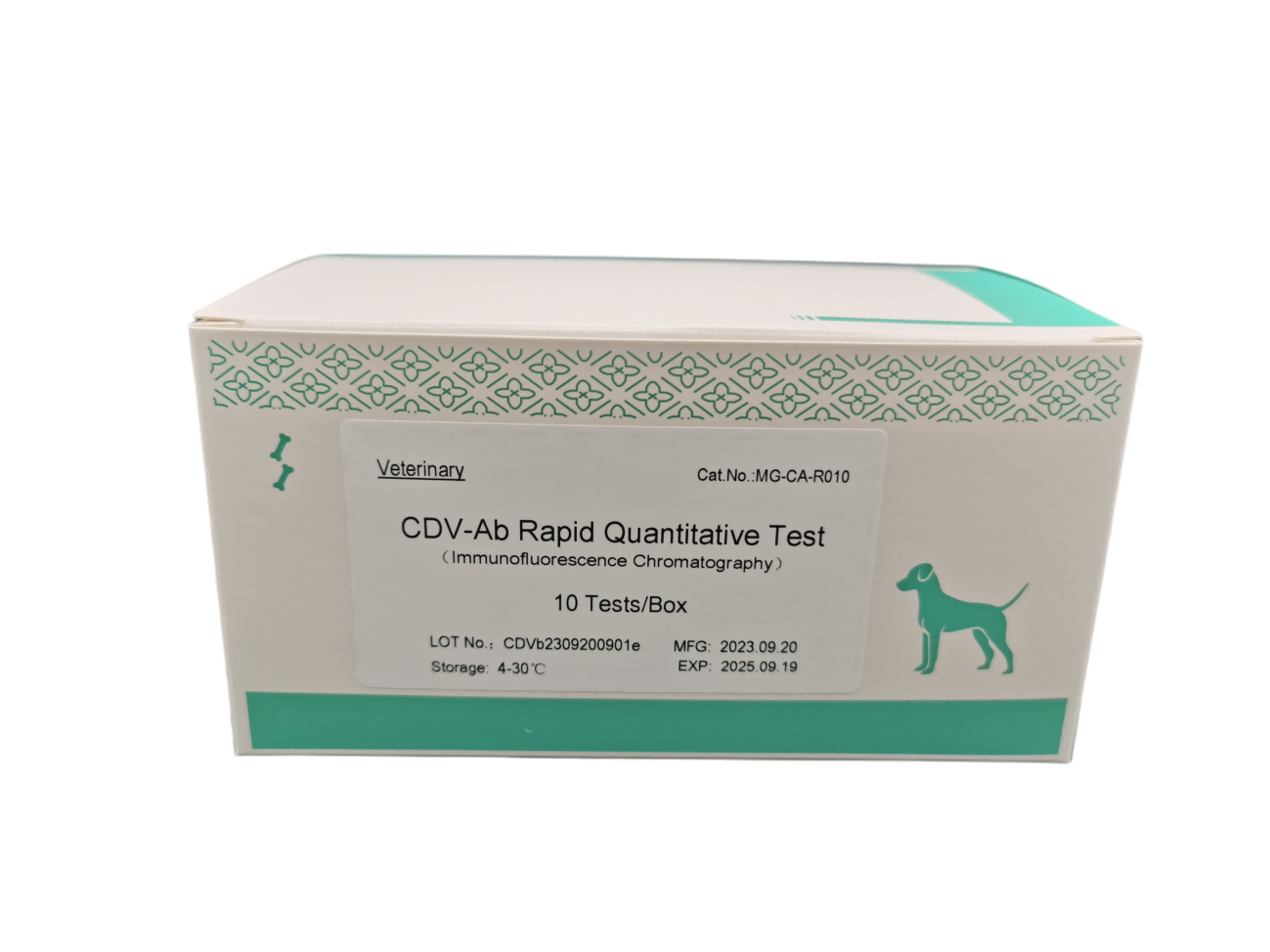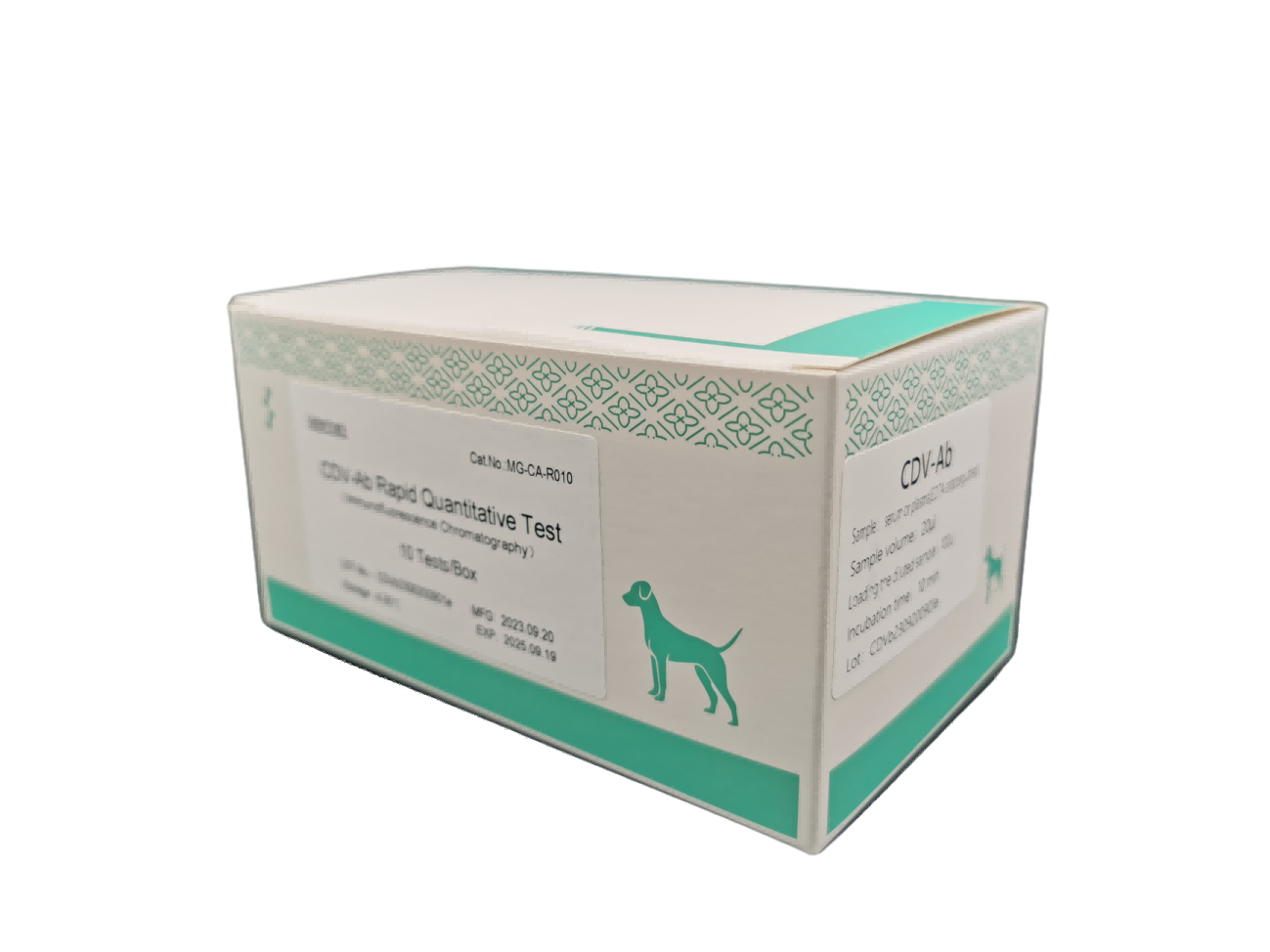SPECIFICATION
10 Tests/Box
Cat. No.: MG-CA-R032
INTENDED USE
The CDV/CPV/CAV Ab test is a fluorescence immunoassay used in conjunction with an Immunofluorescence Analyzer for the quantitative measurement of antibodies against canine distemper virus (CDV), canine parvovirus (CPV), and canine adenovirus (CAV) in serum or plasma samples. This test can provide reference levels of antibody titers after vaccination to determine whether revaccination is necessary. It is also used as an aid in diagnosing and monitoring infections of CDV, CPV, and CAV.
For in vitro diagnostic use only. For professional use only.
TEST PRINCIPLE
This test employs a quantitative double antigen sandwich fluorescence immunoassay. The fluorescent signal intensity corresponds to the amount of CDV-Ab, CPV-Ab, and CAV-Ab captured, with the concentration expressed as Tu/ml.
MATERIALS
Materials Provided
Materials Required but Not Provided
Immunofluorescence Analyzer (for reading test results)
Timer
Pipette (already provided)
Centrifuge (not typically required for antibody tests)
STORAGE AND STABILITY
Store the test kit at 4°C to 30°C until the expiration date.
Once opened, operate the test device at 18°C to 28°C.
Perform the test within 30 minutes of opening the pouch.
SPECIMEN COLLECTION AND PREPARATION
The test can be conducted using serum or plasma (EDTA anticoagulant is recommended).
Separate serum or plasma from blood within 3 hours of collection. Avoid severely hemolyzed specimens.
Perform the test immediately after specimen collection. If testing cannot be done within 3 hours, store the specimen at 2°C to 8°C for no more than 72 hours. For long-term storage, freeze at -20°C or lower.
Bring all materials to room temperature before use. Thaw frozen specimens completely and mix well. Avoid repeated freeze-thaw cycles.
TEST PROCEDURE
Preparation:
Set the Test Device on a clean, level surface.
Insert the ID Chip into the analyzer and ensure the Test Device lot number matches the ID Chip.
Sample Preparation:
-
Running the Test:
Choose between the Standard Test or Quick Test:
(a) Standard Test:
(b) Quick Test:
Pipette 100 μl of the mixed sample into the sample well (S) of the CPV-Ab Test Device.
Click "Quick Test" and start the timer immediately.
Leave the Test Device at room temperature (18°C–28°C) for 10 minutes.
Insert the Test Device into the meter holder and click "Start Test." Select the sample type "Serum/Plasma."
Repeat for the CDV-Ab and CAV-Ab Test Devices.
Pipette 100 μl of the mixed sample into the sample well (S) of the CPV-Ab Test Device.
Click "Standard Test" and insert the CPV-Ab Test Device into the meter holder.
Select the sample type "Serum/Plasma." The meter will automatically start and read the result.
Repeat the same steps for the CDV-Ab and CAV-Ab Test Devices.
Results:
QUALITY CONTROL
Each CDV/CPV/CAV Ab Rapid Quantitative Test includes an internal control for routine quality assurance. If the internal control fails, the meter will display an error message, indicating that the test should be repeated.
INTERPRETATION
Detection range:
CPV-Ab: 4.5–640 Tu/ml
CDV-Ab: 5.0–640 Tu/ml
CAV-Ab: 4.0–640 Tu/ml
Reference Range:
| CPV-Ab (Tu/ml) |
CDV-Ab (Tu/ml) |
CAV-Ab (Tu/ml) |
Level |
Suggestion |
| ≤9 |
≤10 |
≤8 |
0 |
No antibody protection, vaccination recommended. |
| 9–50 |
10–20 |
8–18 |
1 |
Weak antibody protection, consider booster vaccination. |
| 50–150 |
20–50 |
18–40 |
2 |
Moderate protection, monitor antibody levels every 6 months. |
| 150–300 |
50–100 |
40–80 |
3 |
Moderate antibody protection, and strengthen antibody level monitoring, once every 6 months or so. |
300-500
|
100-200 |
80-160 |
4 |
| >500 |
>200 |
>160 |
5 |
Strongest protection, annual testing recommended. |
Note: If the pet has not been vaccinated but shows antibody levels above level 1, it may indicate past infection. Antibody levels may vary due to individual immune responses to vaccination.
WARNINGS AND LIMITATIONS
For in vitro diagnostic use only.
Check packaging and labels before use. Do not use if damaged.
Do not use the test device after the expiration date.
Use a new pipette tip for each specimen.
Procedural errors or substances not listed may cause inaccurate results.




